|
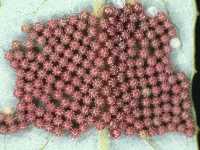
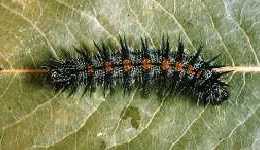
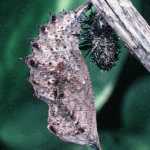
|
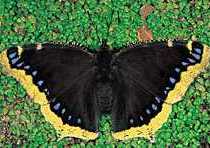
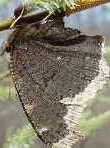 Nymphalis antiopa
Mourning Cloak.
Hosts: deciduous leaves, including the willow, elm, hackberry, cottonwood, poplar, rose, birch, and mulberry trees.
The adult butterfly feeds on tree sap by landing above the flow of sap on a tree and bending its head downward to siphon it.
It also feeds on rotting fruit. It very rarely feeds on flowers, but, in the summer,
the butterfly may feed on the nectar of scabious and knapweed.
Overwintered adults mate in the spring, the males perching in sunny openings during the afternoon
to wait for receptive females.
Eggs are laid in groups circling twigs of the host plant.
Caterpillars live in a communal web and feed together on young leaves, then pupate and emerge as adults in June or July.
The discarded skin from the last instar is often found next to the pupa.
After feeding briefly, the adults estivate until fall, when they re-emerge to feed and store energy for hibernation.
Usually one flight from June-July; adults live 10-11 months and may be our longest lived butterfly.
Nymphalis antiopa
Mourning Cloak.
Hosts: deciduous leaves, including the willow, elm, hackberry, cottonwood, poplar, rose, birch, and mulberry trees.
The adult butterfly feeds on tree sap by landing above the flow of sap on a tree and bending its head downward to siphon it.
It also feeds on rotting fruit. It very rarely feeds on flowers, but, in the summer,
the butterfly may feed on the nectar of scabious and knapweed.
Overwintered adults mate in the spring, the males perching in sunny openings during the afternoon
to wait for receptive females.
Eggs are laid in groups circling twigs of the host plant.
Caterpillars live in a communal web and feed together on young leaves, then pupate and emerge as adults in June or July.
The discarded skin from the last instar is often found next to the pupa.
After feeding briefly, the adults estivate until fall, when they re-emerge to feed and store energy for hibernation.
Usually one flight from June-July; adults live 10-11 months and may be our longest lived butterfly.
|
|
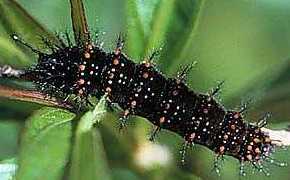
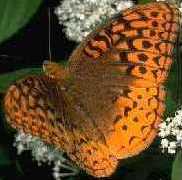
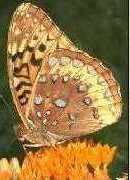 |
|
Speyeria cybele
Great Spangled Fritillary. Hosts:
Various violet species (Viola).
Tiny caterpillar overwinters after hatching from pale brown egg.
Caterpillar black with branching spines that are orange at base; feeds on violets (Viola rotundifolia) at night.
Chrysalis mottled dark brown.
Adults feed on nectar from many species of flowers including milkweeds, thistles, ironweed, dogbane,
mountain laurel, verbena, vetch, bergamot, red clover, joe-pye weed, and purple coneflower.
1 brood; June to mid-September.
Lay eggs late August and September near violets.
Newly-hatched caterpillars do not feed, but overwinter until spring, when they eat young violet leaves.
|
|

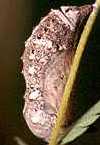
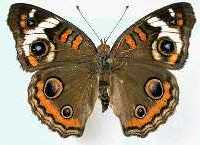
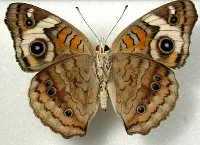
|
|
Junonia coenia
Common Buckeye. Hosts:
pants from the snapdragon family including snapdragon (Antirrhinum) and toadflax (Linaria);
the plantain family including plantains (Plantago);
and the acanthus family including ruellia (Ruellia nodiflora).
Adult favorite nectar sources are composites including aster, chickory, gumweed, knapweed, and tickseed sunflower.
Dogbane, peppermint, and other flowers are also visited.
Females lay eggs singly on leaf buds or on upperside of host plant leaves.
Adults pictured are ups and und.
|




 Nymphalis antiopa
Mourning Cloak.
Hosts: deciduous leaves, including the willow, elm, hackberry, cottonwood, poplar, rose, birch, and mulberry trees.
The adult butterfly feeds on tree sap by landing above the flow of sap on a tree and bending its head downward to siphon it.
It also feeds on rotting fruit. It very rarely feeds on flowers, but, in the summer,
the butterfly may feed on the nectar of scabious and knapweed.
Overwintered adults mate in the spring, the males perching in sunny openings during the afternoon
to wait for receptive females.
Eggs are laid in groups circling twigs of the host plant.
Caterpillars live in a communal web and feed together on young leaves, then pupate and emerge as adults in June or July.
The discarded skin from the last instar is often found next to the pupa.
After feeding briefly, the adults estivate until fall, when they re-emerge to feed and store energy for hibernation.
Usually one flight from June-July; adults live 10-11 months and may be our longest lived butterfly.
Nymphalis antiopa
Mourning Cloak.
Hosts: deciduous leaves, including the willow, elm, hackberry, cottonwood, poplar, rose, birch, and mulberry trees.
The adult butterfly feeds on tree sap by landing above the flow of sap on a tree and bending its head downward to siphon it.
It also feeds on rotting fruit. It very rarely feeds on flowers, but, in the summer,
the butterfly may feed on the nectar of scabious and knapweed.
Overwintered adults mate in the spring, the males perching in sunny openings during the afternoon
to wait for receptive females.
Eggs are laid in groups circling twigs of the host plant.
Caterpillars live in a communal web and feed together on young leaves, then pupate and emerge as adults in June or July.
The discarded skin from the last instar is often found next to the pupa.
After feeding briefly, the adults estivate until fall, when they re-emerge to feed and store energy for hibernation.
Usually one flight from June-July; adults live 10-11 months and may be our longest lived butterfly.






